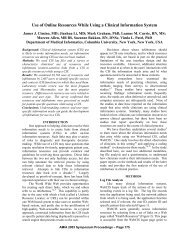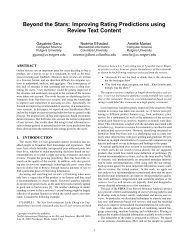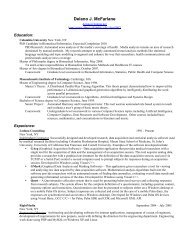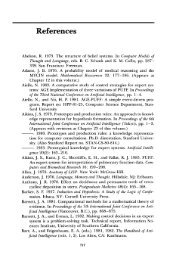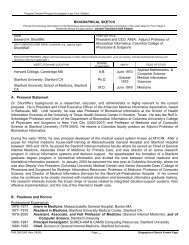Rule-Based Expert Systems: The MYCIN Experiments of the ...
Rule-Based Expert Systems: The MYCIN Experiments of the ...
Rule-Based Expert Systems: The MYCIN Experiments of the ...
You also want an ePaper? Increase the reach of your titles
YUMPU automatically turns print PDFs into web optimized ePapers that Google loves.
Foreword<br />
<strong>The</strong> last seven years have seen <strong>the</strong> field <strong>of</strong> artificial intelligence (AI) transformed.<br />
This transformation is not simple, nor has it yet run its course.<br />
<strong>The</strong> transformation has been generated by <strong>the</strong> emergence <strong>of</strong> expert systems.<br />
Whatever exactly <strong>the</strong>se are or turn out to be, <strong>the</strong>y first arose during <strong>the</strong><br />
1970s, with a triple claim: to be AI systems that used large bodies <strong>of</strong> heuristic<br />
knowledge, to be AI systems that could be applied, and to be <strong>the</strong><br />
wave <strong>of</strong> <strong>the</strong> future. <strong>The</strong> exact status <strong>of</strong> <strong>the</strong>se claims (or even whe<strong>the</strong>r my<br />
statement <strong>of</strong> <strong>the</strong>m is anywhere close to <strong>the</strong> mark) is not important. <strong>The</strong><br />
thrust <strong>of</strong> <strong>the</strong>se systems was strong enough and <strong>the</strong> surface evidence impressive<br />
enough to initiate <strong>the</strong> transformation. This transformation has at<br />
least two components. One comes from <strong>the</strong> resulting societal interest in<br />
AI, expressed in <strong>the</strong> widespread entrepreneurial efforts to capitalize on<br />
AI research and in <strong>the</strong> Japanese Fifth-Generation plans with <strong>the</strong>ir subsequent<br />
worldwide ripples. <strong>The</strong> o<strong>the</strong>r component comes from <strong>the</strong> need to<br />
redraw <strong>the</strong> intellectual map <strong>of</strong> AI to assimilate this new class <strong>of</strong> systemsto<br />
declare it a coherent subarea, or to fragment it into intellectual<br />
that fit <strong>the</strong> existing map, or whatever.<br />
subparts<br />
A side note is important. Even if <strong>the</strong> evidence from politics is not<br />
persuasive, science has surely taught us that more than one revolution can<br />
go on simultaneously. Taken as a whole, science is currently running at<br />
least a score <strong>of</strong> revolutions--not a small number. AI is being transformed<br />
by more than expert systems. In particular, robotics, under <strong>the</strong> press <strong>of</strong><br />
industrial productivity, is producing a revolution in AI in its own right.<br />
Although progressing somewhat more slowly than expert systems at <strong>the</strong><br />
moment, robotics in <strong>the</strong> end will produce an effect at least as large, not<br />
just on <strong>the</strong> applied side, but on <strong>the</strong> intellectual structure <strong>of</strong> <strong>the</strong> field as<br />
well. Even more, both AI and robotics are to some degree parts <strong>of</strong> an<br />
overarching revolution in microelectronics. In any event, to focus on one<br />
revolution, namely expert systems, as I will do here for good reason, is not<br />
to deny <strong>the</strong> importance <strong>of</strong> <strong>the</strong> o<strong>the</strong>rs.<br />
<strong>The</strong> book at whose threshold this foreword stands has (also) a triple<br />
claim on <strong>the</strong> attention <strong>of</strong> someone interested in expert systems and AI.<br />
First, it provides a detailed look at a particular expert system, <strong>MYCIN</strong>.<br />
Second, it is <strong>of</strong> historical interest, for this is not just any old expert system,<br />
but <strong>the</strong> granddaddy <strong>of</strong> <strong>the</strong>m all--<strong>the</strong> one that launched <strong>the</strong> field. Third,<br />
it is an attempt to advance <strong>the</strong> science <strong>of</strong> AI, not just to report on a system<br />
or project. Each <strong>of</strong> <strong>the</strong>se deserves a moment’s comment, for those readers<br />
who will tarry at a foreword before getting on with <strong>the</strong> real story.<br />
<strong>MYCIN</strong> as Example It is sometimes noted that <strong>the</strong> term expert system<br />
is a pun. It designates a system that is expert in some existing human art,<br />
xi
xii Foreword<br />
and thus that operates at human scale--not on some trifling, though perhaps<br />
illustrative task, not on some toy task, to use <strong>the</strong> somewhat pejorative<br />
term popular in <strong>the</strong> field. But it also designates a system that plays <strong>the</strong> role<br />
<strong>of</strong> a consultant, i.e., an expert who gives advice to someone who has a task.<br />
Such a dual picture cannot last long. <strong>The</strong> population <strong>of</strong> so-called expert<br />
systems is rapidly becoming mongrelized to include any system that is applied,<br />
has some vague connection with AI systems and has pretentions <strong>of</strong><br />
success. Such is <strong>the</strong> fate <strong>of</strong> terms that attain (if only briefly) a positive halo,<br />
when advantage lies in shoehorning a system under its protective<br />
ductive cover.<br />
and pro-<br />
<strong>MYCIN</strong> provides a pure case <strong>of</strong> <strong>the</strong> original pun. It is expert in an<br />
existing art <strong>of</strong> human scale (diagnosing bacterial infections and prescribing<br />
treatment for <strong>the</strong>m) and it operates as a consultant (a physician describes<br />
a patient to <strong>MYCIN</strong> and <strong>the</strong> latter <strong>the</strong>n returns advice to <strong>the</strong> physician).<br />
<strong>The</strong> considerations that came to <strong>the</strong> fore because <strong>of</strong> <strong>the</strong> consultant modein<br />
particular, explanation to <strong>the</strong> user--play a strong role throughout all <strong>of</strong><br />
<strong>the</strong> work. Indeed, <strong>MYCIN</strong> makes explicit most <strong>of</strong> <strong>the</strong> issues with which<br />
any group who would engineer an expert system must deal. It also lays<br />
out some <strong>of</strong> <strong>the</strong> solutions, making clear <strong>the</strong>ir adequacies and inadequacies.<br />
Because <strong>the</strong> <strong>MYCIN</strong> story is essentially complete by now and <strong>the</strong> book tells<br />
it all, <strong>the</strong> record <strong>of</strong> initial work and response gives a perspective on <strong>the</strong><br />
development <strong>of</strong> a system over time. This adds substantially to <strong>the</strong> timesliced<br />
picture that constitutes <strong>the</strong> typical system description. It is a good<br />
case to study, even though, if we learn our lessons from it and <strong>the</strong> o<strong>the</strong>r<br />
early expert systems, we will not have to recapitulate<br />
again.<br />
exactly this history<br />
One striking feature <strong>of</strong> <strong>the</strong> <strong>MYCIN</strong> story, as told in this book, is its<br />
eclecticism. Those outside a system’s project tend to build brief, trenchant<br />
descriptions <strong>of</strong> a system. <strong>MYCIN</strong> is an example <strong>of</strong> approach X leading to<br />
a system <strong>of</strong> type Y. Designers <strong>the</strong>mselves <strong>of</strong>ten characterize <strong>the</strong>ir own systems<br />
in such abbreviated terms, seeking to make particular properties<br />
stand out. And, <strong>of</strong> course, critics do also, although <strong>the</strong> properties <strong>the</strong>y<br />
choose to highlight are not usually <strong>the</strong> same ones. Indeed, I myself use<br />
such simplified views in this very foreword. But if this book makes anything<br />
clear, it is that <strong>the</strong> <strong>MYCIN</strong> gang (as <strong>the</strong>y called <strong>the</strong>mselves) continually<br />
explored, <strong>of</strong>ten with experimental variants, <strong>the</strong> full range <strong>of</strong> ideas in <strong>the</strong><br />
AI armamentarium. We would undoubtedly see that this is true <strong>of</strong> many<br />
projects if we were to follow <strong>the</strong>ir histories carefully. However, it seems to<br />
have been particularly true <strong>of</strong> <strong>the</strong> effort described here.<br />
<strong>MYCIN</strong> as History <strong>MYCIN</strong> comes out <strong>of</strong> <strong>the</strong> Stanford Heuristic Programming<br />
Project (HPP), <strong>the</strong> laboratory that without doubt has had <strong>the</strong><br />
most impact in setting <strong>the</strong> expert-system transformation in motion and<br />
determining its initial character. I said that <strong>MYCIN</strong> is <strong>the</strong> granddaddy <strong>of</strong><br />
expert systems. I do not think it is so viewed in HPP. <strong>The</strong>y prefer to talk<br />
about DENDRAL, <strong>the</strong> system for identifying chemical structures from<br />
mass spectrograms (Lindsay, Buchanan, Feigenbaum, and Lederberg,
Foreword xiii<br />
1980), as <strong>the</strong> original expert system (Feigenbaum, 1977). True, DENDRAL<br />
was <strong>the</strong> original system built by <strong>the</strong> group that became HPP, and its origins<br />
go back into <strong>the</strong> mid-1960s. Also true is that many basic design decisions<br />
that contributed to <strong>MYCIN</strong> came from lessons learned in DENDRAL. For<br />
instance, <strong>the</strong> basic production-system representation had been tried out in<br />
DENDRAL for modeling <strong>the</strong> mass spectrometer, and it proved highly serviceable,<br />
as seen in all <strong>the</strong> work on Meta-DENDRAL, which learned production<br />
rules. And certainly true, as well, is that <strong>the</strong> explicit focus on <strong>the</strong><br />
role <strong>of</strong> expertise in AI systems predates <strong>MYCIN</strong> by a long stretch. I trace<br />
<strong>the</strong> focus back to Joel Moses’s dissertation at M.I.T. in symbolic integration<br />
(Moses, 1967), which led to <strong>the</strong> MACSYMA project on symbolic ma<strong>the</strong>matics<br />
(Mathlab Group, 1977), a system <strong>of</strong>ten included in <strong>the</strong> roster<br />
early expert systems.<br />
Even so, <strong>the</strong>re are grounds for taking DENDRAL and MACSYMA as<br />
precursors. DENDRAL has strong links to classical problem-solving programs,<br />
with a heuristically shaped combinatorial search in a space <strong>of</strong> all<br />
isomers at its heart and a representation (<strong>the</strong> chemical valence model) that<br />
provided <strong>the</strong> clean space within which to search. DENDRAL started out<br />
as an investigation into scientific induction (on real tasks, to be sure) and<br />
only ended up becoming an expert system when that view gradually<br />
emerged. <strong>MYCIN</strong>, on <strong>the</strong> o<strong>the</strong>r hand, was a apure rule-based system that<br />
worked in an area unsupported by a clean, gcientifically powerful representation.<br />
Its search was limited enough (being nongenerative in an important<br />
sense) to be relegated to <strong>the</strong> background; thus <strong>MYCIN</strong> could be<br />
viewed purely as a body <strong>of</strong> knowledge. <strong>MYCIN</strong> embodied all <strong>the</strong> features<br />
that have (it must be admitted) become <strong>the</strong> clich6s <strong>of</strong> what expert systems<br />
are. MACSYMA also wears <strong>the</strong> mantle <strong>of</strong> original expert system somewhat<br />
awkwardly. It has never been an AI system in any central way. It has been<br />
regarded by those who created it, and now nurture it, as not belonging to<br />
<strong>the</strong> world <strong>of</strong> AI at all, but ra<strong>the</strong>r to <strong>the</strong> world <strong>of</strong> symbolic ma<strong>the</strong>matics.<br />
Only its roots lie in AI--though <strong>the</strong>y certainly include <strong>the</strong> attitude that<br />
computer systems should embody as much expertise as possible (which<br />
may or may not imply a large amount <strong>of</strong> knowledge).<br />
My position here is as an outsider, for I did not witness <strong>the</strong> day-to-day<br />
development <strong>of</strong> <strong>MYCIN</strong> in <strong>the</strong> research environment within which (in <strong>the</strong><br />
early 1970s) DENDRAL was <strong>the</strong> reigning success and paradigm. But I still<br />
like my view that <strong>MYCIN</strong> is <strong>the</strong> original expert system that made it evident<br />
to all <strong>the</strong> rest <strong>of</strong> <strong>the</strong> world that a new niche had opened up. Indeed, an<br />
outsider’s view may have a validity <strong>of</strong> its own. It is, at least, certain that in<br />
<strong>the</strong> efflorescence <strong>of</strong> medical diagnostic expert systems in <strong>the</strong> 1970s (CAS-<br />
NET, INTERNIST, and <strong>the</strong> Digitalis <strong>The</strong>rapy Advisor; see Szolovits,<br />
1982), <strong>MYCIN</strong> epitomized <strong>the</strong> new path that had been created. Thus,<br />
ga<strong>the</strong>ring toge<strong>the</strong>r <strong>the</strong> full record <strong>of</strong> this system and <strong>the</strong> internal history<br />
<strong>of</strong> its development serves to record an important event in <strong>the</strong> history <strong>of</strong><br />
AI.<br />
<strong>MYCIN</strong> as Science <strong>The</strong> first words <strong>of</strong> this foreword put forth <strong>the</strong><br />
image <strong>of</strong> a development within AI <strong>of</strong> uncertain character, one that needed
xiv Foreword<br />
to be assimilated. Whatever effects are being generated on <strong>the</strong> social organization<br />
<strong>of</strong> <strong>the</strong> field by <strong>the</strong> development <strong>of</strong> an applied wing <strong>of</strong> AI, <strong>the</strong><br />
more important requirement for assimilation, as far as I am concerned,<br />
comes from <strong>the</strong> scientific side. Certainly, <strong>the</strong>re is nothing very natural about<br />
expert systems as a category, although <strong>the</strong> term is useful for <strong>the</strong> cluster <strong>of</strong><br />
systems that is causing <strong>the</strong> transformation.<br />
AI is both an empirical discipline and an engineering discipline. This<br />
has many consequences for its course as a science. It progresses by building<br />
systems and demonstrating <strong>the</strong>ir performance. From a scientific point <strong>of</strong><br />
view, <strong>the</strong>se systems are <strong>the</strong> data points out <strong>of</strong> which a cumulative body <strong>of</strong><br />
knowledge is to develop. However, an AI system is a complex join <strong>of</strong> many<br />
mechanisms, some new, most familiar. Of necessity, on <strong>the</strong> edge <strong>of</strong> <strong>the</strong> art,<br />
systems are messy and inelegant joins--that’s <strong>the</strong> nature <strong>of</strong> frontiers. It is<br />
difficult to extract from <strong>the</strong>se data points <strong>the</strong> scientific increments that<br />
should be added to <strong>the</strong> cumulation. Thus, AI is case-study science with a<br />
vengeance. But if that were not enough <strong>of</strong> a problem, <strong>the</strong> pay<strong>of</strong>f structure<br />
<strong>of</strong> AI permits <strong>the</strong> extraction to be put <strong>of</strong>f, even to be avoided permanently.<br />
If a system performs well and breaks new ground--which can <strong>of</strong>ten be<br />
verified by global output measures and direct qualitative assessment--<strong>the</strong>n<br />
it has justified its construction. Global conclusions, packaged as <strong>the</strong> discursive<br />
views <strong>of</strong> its designers, are <strong>of</strong>ten <strong>the</strong> only increments to be added<br />
to <strong>the</strong> cumulated scientific base.<br />
Of course, such a judgment is too harsh by half. <strong>The</strong> system itself<br />
constitutes a body <strong>of</strong> engineering know-how. Through direct study and<br />
emulation, <strong>the</strong> next generation <strong>of</strong> similar systems benefits. However, <strong>the</strong><br />
entire history <strong>of</strong> science shows no alternative to <strong>the</strong> formation <strong>of</strong> explicit<br />
<strong>the</strong>ories, with <strong>the</strong>ir rounds <strong>of</strong> testing and modification, as <strong>the</strong> path to genuine<br />
understanding and control <strong>of</strong> any domain, whe<strong>the</strong>r natural or technological.<br />
In <strong>the</strong> present state <strong>of</strong> AI, it is all too easy to move on to <strong>the</strong><br />
next system without devoting sufficient energies to trying to understand<br />
what has already been wrought and to doing so in a way that adds to <strong>the</strong><br />
explicit body <strong>of</strong> science. An explosive development, such as that <strong>of</strong> expert<br />
systems, is just <strong>the</strong> place where engineering progress can be expected to<br />
occur pell-mell, with little attention to obtaining o<strong>the</strong>r than global scientific<br />
lessons.<br />
This situation is not to be condemned out <strong>of</strong> hand, but accepted as a<br />
basic condition <strong>of</strong> our field. For <strong>the</strong> difficulties mentioned above stem from<br />
<strong>the</strong> sources that generate our progress. Informal and experiential techniques<br />
work well because programmed systems are so open to direct inspection<br />
and assessment, and because <strong>the</strong> loop to incremental change and<br />
improvement is so short, with interactive creation and modification. AI,<br />
like any o<strong>the</strong>r scientific field, must find its own particular way to science,<br />
building on its own structure and strengths. But <strong>the</strong> field is young, and<br />
that way is not yet clear. We must continue to struggle to find out how to<br />
extract scientific knowledge from our data points. <strong>The</strong> situation is hardly<br />
unappreciated, and many people in <strong>the</strong> field are trying <strong>the</strong>ir hands at<br />
varying approaches, from formal <strong>the</strong>ory to more controlled system exper-
Foreword xv<br />
imentation. <strong>The</strong>re has been exhortation as well. Indeed, I seem to have<br />
done my share <strong>of</strong> exhortation, especially with respect to expert systems.<br />
<strong>The</strong> editors <strong>of</strong> <strong>the</strong> present volume, in inviting me to provide a foreword<br />
to it, explicitly noted that <strong>the</strong> book was (in small part) an attempt to meet<br />
<strong>the</strong> calls I had made for more science from our expert-systems experiments.<br />
And recently, Harry Pople asserted that his attempt at articulating<br />
<strong>the</strong> task domain <strong>of</strong> medical diagnosis for INTERNIST was (again, in small<br />
part) a response to exhortation (he called it criticism) <strong>of</strong> mine (Pople, 1982).<br />
I am not totally comfortable with <strong>the</strong> role <strong>of</strong> exhorter--I prefer to be in<br />
<strong>the</strong> trenches. However, if comments <strong>of</strong> mine have helped move anyone to<br />
devote energy to extracting <strong>the</strong> science from our growing experience with<br />
expert systems, I can only rejoice.<br />
<strong>The</strong> third claim <strong>of</strong> this book, <strong>the</strong>n, is to extract and document <strong>the</strong><br />
scientific lessons from <strong>the</strong> experience with <strong>MYCIN</strong>. This extraction and<br />
documentation occurs at two levels. First, <strong>the</strong>re has been a very substantial<br />
exploration in <strong>the</strong> last decade <strong>of</strong> many <strong>of</strong> <strong>the</strong> questions that were raised<br />
by <strong>MYCIN</strong>. Indeed, <strong>the</strong>re are some 26 contributors to this book, even<br />
though <strong>the</strong> number <strong>of</strong> people devoted to <strong>MYCIN</strong> proper at any one time<br />
was never very large. Ra<strong>the</strong>r, <strong>the</strong> large number <strong>of</strong> contributors reflects <strong>the</strong><br />
large number <strong>of</strong> follow-on and alternative-path studies that have been undertaken.<br />
This book documents this work. It does so by collecting <strong>the</strong><br />
papers and reports <strong>of</strong> <strong>the</strong> original researchers that did <strong>the</strong> work, but <strong>the</strong><br />
present editors have made substantial revisions to smooth <strong>the</strong> whole into<br />
a coherent story. This story lays to rest <strong>the</strong> simplified view that <strong>MYCIN</strong><br />
was a single system that was designed, built, demonstrated and refined; or<br />
even that it was only a two-stage affair--<strong>MYCIN</strong>, <strong>the</strong> original task-specific<br />
system, followed by a single stage <strong>of</strong> generalization into E<strong>MYCIN</strong>, a kernel<br />
system that could be used in o<strong>the</strong>r tasks. <strong>The</strong> network <strong>of</strong> studies was much<br />
more ramified, and <strong>the</strong> approaches considered were more diverse.<br />
<strong>The</strong> step to E<strong>MYCIN</strong> does have general significance. It represents a<br />
major way we have found <strong>of</strong> distilling our knowledge and making it available<br />
to <strong>the</strong> future. It is used ra<strong>the</strong>r widely; for example, <strong>the</strong> system called<br />
EXPERT (Kulikowski and Weiss, 1982) bears <strong>the</strong> same relation to <strong>the</strong> CAS-<br />
NET system as E<strong>MYCIN</strong> does to <strong>MYCIN</strong>. It is <strong>of</strong> a piece with <strong>the</strong> strategy<br />
<strong>of</strong> building special-purpose problem-oriented programming languages to<br />
capture a body <strong>of</strong> experience about how to solve a class <strong>of</strong> problems, a<br />
strategy common throughout computer science. <strong>The</strong> interesting aspect <strong>of</strong><br />
this step, from <strong>the</strong> perspective <strong>of</strong> this foreword, is its attempt to capitalize<br />
on <strong>the</strong> strong procedural aspects <strong>of</strong> <strong>the</strong> field. <strong>The</strong> scientific abstraction is<br />
embodied in <strong>the</strong> streamlined and clean structure <strong>of</strong> <strong>the</strong> kernel system (or<br />
programming language). <strong>The</strong> scientific advance is communicated by direct<br />
study <strong>of</strong> <strong>the</strong> new artifact and, importantly, by its use. Such kernel systems<br />
still leave much to be desired as a vehicle for science. For example, evaluation<br />
still consists in global discussion <strong>of</strong> features and direct experience,<br />
and assessment <strong>of</strong> its use. (Witness <strong>the</strong> difficulty that computer science has<br />
in assessing programming languages, an entirely analogous situation.) Still,
xvi Foreword<br />
<strong>the</strong> strategy represented by E<strong>MYCIN</strong> is an important and novel response<br />
by AI to producing science.<br />
<strong>The</strong> second level at which this book addresses <strong>the</strong> question <strong>of</strong> science<br />
is in surveying <strong>the</strong> entire enterprise and attempting to draw <strong>the</strong> major<br />
lessons (see especially <strong>the</strong> last chapter). Here <strong>the</strong> editors have faced a hard<br />
task. Of necessity, <strong>the</strong>y have had to deal with all <strong>the</strong> complexity <strong>of</strong> a case<br />
study (more properly, <strong>of</strong> a collection <strong>of</strong> <strong>the</strong>m). Thus, <strong>the</strong>y have had<br />
settle for reflecting on <strong>the</strong> enterprise and its various products and experiences,<br />
and to encapsulate <strong>the</strong>se in what I re[erred to above as qualitative<br />
discussion. But <strong>the</strong>y have a long perspective available to <strong>the</strong>m, and <strong>the</strong>re<br />
is a lot <strong>of</strong> substance in <strong>the</strong> individual studies. Thus, <strong>the</strong> lessons that <strong>the</strong>y<br />
draw are indeed a contribution to our understanding <strong>of</strong> expert systems.<br />
In sum, for all <strong>the</strong>se reasons I’ve enumerated, I commend to you a<br />
volume that is an important addition to <strong>the</strong> literature on AI expert systems.<br />
It is noteworthy that <strong>the</strong> Stanford Heuristic Programming Project previously<br />
produced an analogous book describing <strong>the</strong> DENDRAL effort and<br />
summarizing <strong>the</strong>ir experience with it (Lindsay, Buchanan, Feigenbaum and<br />
Lederberg, 1980). Thus, HPP has done its bit twice. It is well ahead <strong>of</strong><br />
many <strong>of</strong> <strong>the</strong> rest <strong>of</strong> us in providing valuable increments to <strong>the</strong> accumulation<br />
<strong>of</strong> knowledge about expert systems.<br />
Pittsburgh, Pennsylvania<br />
March 1984<br />
REFERENCES<br />
Allen Newell<br />
Feigenbaum, E. A. <strong>The</strong> art <strong>of</strong> artificial intelligence: <strong>The</strong>mes and case studies<br />
in knowledge engineering. In Proceedings <strong>of</strong> <strong>the</strong> Fifth International<br />
Joint Conference on Artificial Intelligence. Pittsburgh, PA: Computer Science<br />
Department, Carnegie-Mellon University, 1977.<br />
Kulikowski, C. A., and Weiss, S. M. Representation <strong>of</strong> expert knowledge<br />
for consultation: <strong>The</strong> CASNET and EXPERT projects. In E Szolovits<br />
(ed.), Artificial<br />
1982.<br />
Intelligence in Medicine. Boulder, CO: Westview Press,<br />
Lindsay, R. K., Buchanan, B. G., Feigenbaum, E. A., and Lederberg, J.<br />
Applications <strong>of</strong> Artificial Intelligence to Chemistry: <strong>The</strong> DENDRAL Project.<br />
New York: McGraw-Hill, 1980.<br />
Mathlab Group. MACSYMA Reference<br />
ence Laboratory, M.I.T., 1977.<br />
Manual (Tech. Rep.). Computer Sci-<br />
Moses, J. Symbolic Integration. Doctoral dissertation, M.I.T., 1967.<br />
Pople, H. E., Jr. Heuristic methods for imposing structure on ill-structured<br />
problems: <strong>The</strong> structuring <strong>of</strong> medical diagnosis. In E Szolovits, (ed.),<br />
Artificial Intelligence in Medicine. Boulder, CO: Westview Press, 1982.<br />
Szolovits, P. Artificial<br />
1982.<br />
Intelligence in Medicine, Boulder, CO: Westview Press,



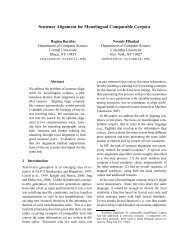
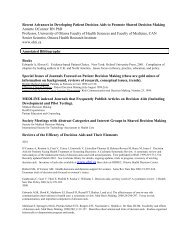
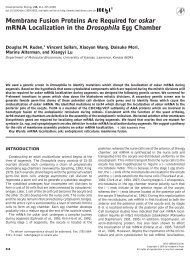
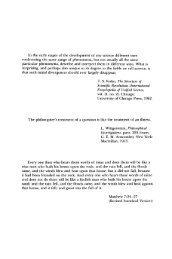
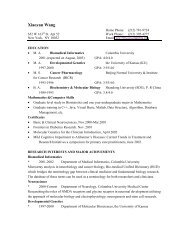
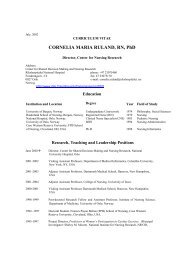
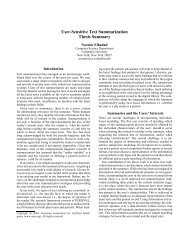
![[1998] Automated Knowledge Extraction from the UMLS - People ...](https://img.yumpu.com/31540760/1/190x245/1998-automated-knowledge-extraction-from-the-umls-people-.jpg?quality=85)
